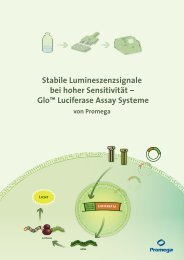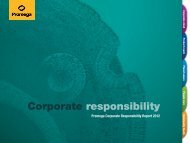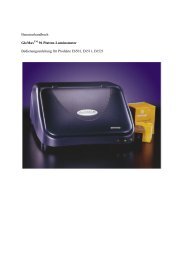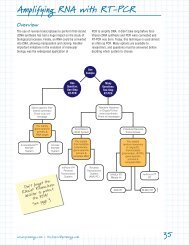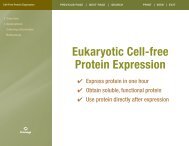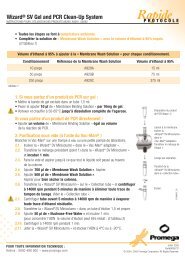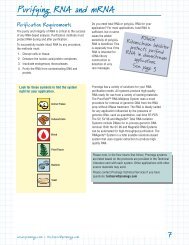Screening for Recombinants - Promega
Screening for Recombinants - Promega
Screening for Recombinants - Promega
You also want an ePaper? Increase the reach of your titles
YUMPU automatically turns print PDFs into web optimized ePapers that Google loves.
<strong>Screening</strong> <strong>for</strong> <strong>Recombinants</strong><br />
Troubleshooting Subcloning Experiments<br />
Symptoms Possible Causes Comments<br />
Few or no colonies obtained Cells not competent Competent cells may exhibit lower<br />
after trans<strong>for</strong>mation<br />
trans<strong>for</strong>mation efficiencies 5–6 weeks<br />
after preparation. To verify that bacteria<br />
are competent, per<strong>for</strong>m a test<br />
trans<strong>for</strong>mation using a known amount<br />
of a standard supercoiled plasmid<br />
(see page 47).<br />
Unsuccessful ligation<br />
Analyze samples of a linearized vector and<br />
the vector + insert ligation on an 0.8%<br />
agarose gel. If ligation was successful, the<br />
banding pattern of the ligation products<br />
should be different from that of the<br />
unligated sample.<br />
Inactive T4 DNA Ligase<br />
Verify that the T4 DNA Ligase is active;<br />
per<strong>for</strong>m a control ligation reaction with<br />
linear plasmid DNA.<br />
Inactive T4 DNA Ligase Buffer Store T4 DNA Ligase 10X Reaction Buffer in<br />
small aliquots at –20°C to minimize freezethaw<br />
cycles of the buffer. Multiple freezethaw<br />
cycles may degrade the ATP in the buffer.<br />
Digested vector ends are not Restriction enzyme sites that are adjacent<br />
compatible with the fragment within the multiple cloning region or near<br />
the ends can prove difficult to digest<br />
completely. See page 40 <strong>for</strong> a method to<br />
create PCR products with restriction sites<br />
in the primers.<br />
Excess ligation products<br />
The added ligation products should not<br />
added to competent cells<br />
exceed 0.5% of the trans<strong>for</strong>mation reaction<br />
volume. Excess DNA (>10ng) may also<br />
inhibit the trans<strong>for</strong>mation.<br />
High Background Unsuccessful dephosphorylation Attempt to religate the dephosphorylated<br />
of vector DNA<br />
vector. It should religate with low efficiency.<br />
Plates lack the correct antibiotic; Per<strong>for</strong>m a mock trans<strong>for</strong>mation with no DNA<br />
the antibiotic is inactive<br />
added. If colonies grow, discard the plates.<br />
Ratio of linearized, phosphorylated Reduce the amount of linearized vector in<br />
vector to insert DNA is too high the reaction. Religation of the vector is<br />
favored when the vector:insert ratio is too high.<br />
54<br />
<strong>Promega</strong> Subcloning Notebook





